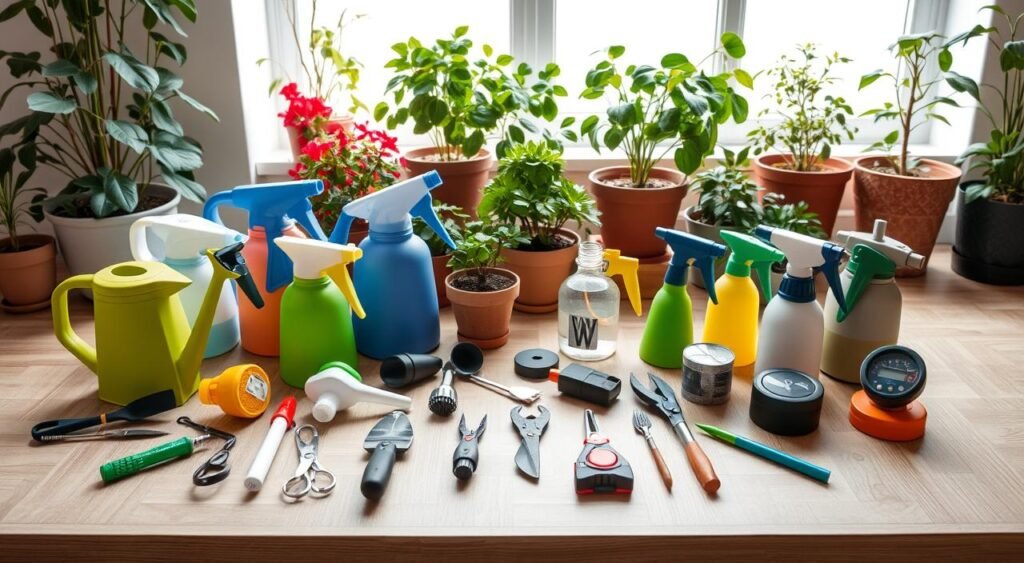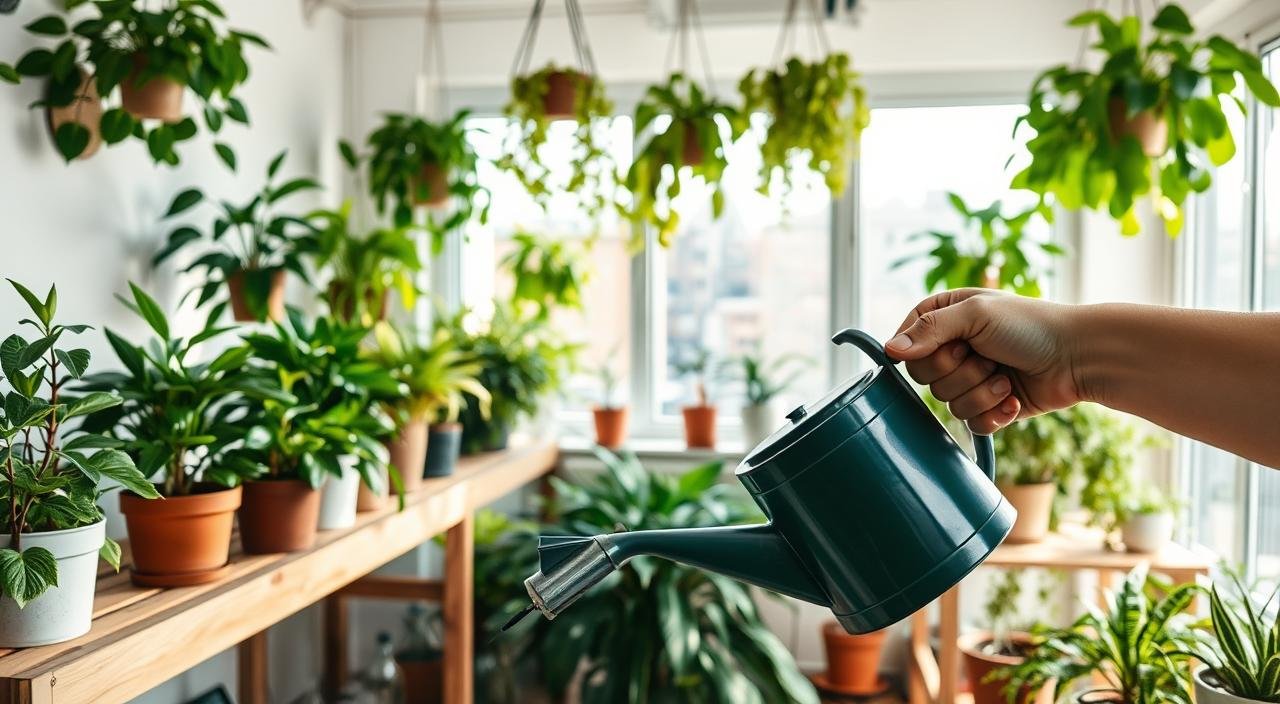Did you know 25% of houseplants die from overwatering, a preventable issue with the right techniques1? Proper watering is the backbone of indoor plant care, yet many struggle to balance frequency and quantity. For instance, a 5′ Snake Plant needs watering only once a month in summer but every two months in winter1, while Peace Lilies require more frequent attention1. Tools like the Sancruz IC205S pump, delivering 400ml/minute at $30, or the Onsast AUTO01 at $13.50, offer automated solutions for busy plant owners2. Even a simple finger test—one inch deep into soil—can save plants from drowning or drying out3.
Ignoring these basics leads to browning leaves, root rot, or costly replacements. Tropical varieties like Aglaaonema demand weekly watering in summer1, while cacti thrive with less. Automated systems like self-watering pots or adjustable drippers can simplify care, especially during vacations2. Start by learning your plants’ needs and matching them to tools like moisture meters or drip irrigation3.
Key Takeaways
- Overwatering kills 1 in 4 houseplants1.
- Automatic pumps like Sancruz (400ml/min) and Onsast (adjustable speed) cost between $13.50-$502.
- Check soil weekly using the finger test or moisture meters3.
- Plants survive 7-24 days without water, but timing varies by type and pot size1.
- Use room-temperature water to avoid root shock3.
Understanding the Basics of Indoor Plant Care
And if you’re working with a sprawling collection of indoor plants, that can mean distributing several gallons of water weekly. Even one short spell of spotty care can send the whole operation into a tailspin.
Proper watering forms the backbone of indoor plant care. Water delivers nutrients, fuels photosynthesis, and maintains plant structure. Most houseplants thrive with weekly watering in active growth phases but require less in winter, needing just a few times monthly4. Ignoring these rhythms disrupts their health, limiting indoor plant benefits like air purification and stress reduction.
Importance of Proper Watering
Water’s role extends beyond hydration. It enables nutrient absorption and cell expansion, directly linking to plant vitality. For instance, snake plants tolerate drying out between waterings, while peace lilies prefer drier soil surfaces4. Terra cotta pots help manage moisture, as their porous design slows evaporation5.
How Watering Affects Growth
Overwateringing ranks as the top cause of houseplant death, causing root rot and mold6. Underwatered plants show wilting leaves, while overwatered ones develop yellowing or fungal growth. Proper techniques ensure lush foliage and robust stems, enhancing indoor plant benefits like humidity regulation.
Common Watering Mistakes
- Overwatering: Drowns roots, leading to rot6.
- Ignoring seasonal needs: Pothos and rubber plants require less water in winter4.
- Temperature neglect: Watering cold soil harms roots5.
Each plant’s needs vary—dumb cane prefers moist soil, while ponytail palms need dry periods4.
Choosing the Right Watering Method

Picking between manual and automated watering depends on your routine and plant needs. Both methods have unique benefits for houseplants and require attention to soil conditions.
Manual Watering vs. Automated Systems
Manual watering lets you inspect soil moisture directly. Stick a finger one inch into soil—if dry, water; if damp, wait7. Morning watering reduces evaporation and disease risks8. Automated systems like the Sancruz IC205S and Onsast AUTO01 suit large collections or frequent travelers8.
Best Tools for Indoor Plant Watering
Essential tools include:
- Narrow-spout watering cans for precise delivery7
- Moisture meters from brands like Arber or Urban Leaf for accuracy8
- Automated drip systems like Bloem Living’s models for consistent care
Use filtered water to avoid mineral buildup in sensitive best indoor plants like ferns8. Always test soil before watering to prevent overwatering, a common issue for houseplants7.
Factors Influencing Water Requirements
Understanding how different elements shape your indoor plant care routine starts with these three key factors:
“The golden rule for watering is to do so when the top inch of soil feels dry, which is a common indicator for many houseplants.”9
Type of Plant and Its Needs
Succulents like Aloe Vera require minimal watering, while ferns thrive in moist soil9. Air-purifying plants such as Peace Lilies need consistent moisture, but low light indoor plants like Snake Plants prefer drier conditions. Soil type matters too—soil mixes with perlite drain faster than peat-based blends9.
| Plant Type | Water Frequency | Example |
|---|---|---|
| Succulents | Every 2-3 weeks | Cactus |
| Ferns | Weekly | Boston Fern |
| Air-purifying | Bi-weekly | Spider Plant |
Climate and Seasonal Changes
Winter heating lowers humidity, drying soil faster than in summer10. Most indoor plants grow best at 70–80°F daytime and 65–70°F nighttime10. During summer, plants in bright windows may need watering every 3–4 days, while winter watering can drop to every 7–10 days10.
Soil Type and Drainage
Clay soils hold moisture longer than sandy mixes9. Use pots with drainage holes to avoid root rot9. A mix of peat moss and sand suits low light indoor plants, while cacti prefer gravel added to improve drainage9.
- Peat-based soil retains moisture
- Sandy/gravely mixes drain faster
- Add perlite for better aeration
Adjusting to these factors ensures healthy growth for all air-purifying plants and low light indoor plants.
Signs of Underwatering and Overwatering

Spotting water stress early is key to saving houseplants. Overwatering is the top issue, affecting many owners11. Learn the telltale signs to adjust care in time.
| Symptom | Underwatering | Overwatering |
|---|---|---|
| Leaf Condition | Brown edges, crispy texture | Soft yellow leaves with brown tips |
| Soil State | Pulled away from pot walls | Mold/algae growth on surface |
| Root Health | Firm, light-colored roots | Mushy, discolored roots12 |
Yellowing Leaves and Drooping
Crispy brown leaf edges signal underwatering12, while soft yellowing on lower leaves points to overwatering. Drooping leaves that rebound after watering hint at neglect11. Persistent drooping with soggy soil means overwatering.
Root Rot Symptoms
Foul odors and black, mushy roots indicate advanced rot12. Early signs include stunted growth. Check roots by gently removing soil to inspect for decay.
Soil Dryness or Saturation
Test soil with a finger 1-2 inches deep. Dry soil needs watering; saturation means overwatering. Moisture meters help avoid guesswork, but budget users may prioritize vulnerable plants11.
Best Practices for Indoor Plant Watering
Successful indoor plant care starts with adapting watering to each plant’s needs. Over 70% of new gardeners struggle with timing13, but these strategies simplify the process.
Frequency of Watering
Forget rigid schedules. Use the “check before you water” method: stick your finger 1–2 inches into soil or use a moisture meter. Most houseplants prefer watering when the top inch of soil is dry. For example, cacti and succulents thrive when soil dries completely between waterings13. A 75% majority of gardeners trust this tactile approach13.
- Moisture check every 3–4 days for tropical plants
- Reduce frequency for plants like snake plants and ZZ plants
Water Quality Considerations
Tap water’s chlorine and fluoride can harm sensitive plants. Let it sit 24 hours to evaporate chemicals14. Avoid softened water—30% of common best indoor plants suffer from sodium damage13. For plants like spider plants, use distilled or rainwater to prevent leaf burn14.
Watering Techniques
Match methods to plant type. Top-watering works for most plants, but always drain excess water to avoid root rot (20% risk if ignored)13. Use bottom watering for African violets and ferns. Leach pots every 4–6 months to remove mineral buildup by pouring twice the pot’s volume of water through soil14.
| Plant Type | Method | Frequency |
|---|---|---|
| Cacti/Succulents | Wait until soil is dry | Every 2–3 weeks |
| Pothos/Peace Lily | Top-watering until drainage | Every 7–10 days |
| African Violet | Bottom watering | When topsoil dries |
Creating an Irrigation Schedule

Effective indoor plant care starts with a tailored watering plan. Begin by grouping best indoor plants by their moisture needs. For example, jade pothos thrive with watering every 10 days15, while Alocasia Polly prefers moist soil and needs watering every 6-7 days15
Daily vs. Weekly Watering Plans
- Daily checks: Use automated systems like Sancruz, which simplifies adjustments15. Some plants like ferns need frequent monitoring due to high moisture loss16.
- Weekly routines: Schedule watering every 5-10 days for most indoor plants, adjusting for plant type. Succulents may only need water every 3 weeks17.
| Plant Type | Watering Frequency |
|---|---|
| Ferns | Every 5-7 days |
| Sansevieria | Every 2-3 weeks |
| Alocasia | 6-7 days |
Adjusting for Seasonal Variations
In winter, reduce watering by 30-50% to match slower growth15. Use this guide:
“Sancruz was the easiest to program. … Onsast’s interface is a different story.”
- Summer: Increase frequency for tropical plants like Calathea17.
- Winter: Water every 10-14 days for most varieties16.
Track schedules using Google Sheets or a 30-day grid on graph paper15. Pair this with the fingertip test: water when top 2 inches of soil are dry17.
Specialized Irrigation Systems for Indoor Plants
Modern indoor plant decoration thrives with smart irrigation tools. These systems automate watering, ensuring plants stay healthy without constant manual care. Explore options like self-watering pots, drip setups, and hydroponic designs that fit any space.
Self-Watering Pots
Self-watering pots use reservoirs and wicking to maintain soil moisture. The LetPot Automatic Watering System 2.0 holds top reviews with 202 customer ratings18. It waters up to 20 plants at $59.99 (regular $69.99)18. Its pump delivers 12 gallons per hour quietly at 30 dB18.
Drip Irrigation Options
Smart drip systems like the LetPot Smart Drip Irrigation offer precise control. Features include:
- USB 5V power supply19
- Wi-Fi connectivity for remote control19
- Adjustable flow rates from 200–450 ml/min19
These systems work with iOS/Android apps, enabling schedules and real-time alerts19.
Hydroponic Systems
Hydroponic setups grow plants without soil. Many kits include built-in water tanks, reducing manual refills. The LetPot system’s IPX2 rating protects against splashes18. These setups pair well with sleek containers for modern indoor plant decoration.
| System | Capacity | Price | Key Feature |
|---|---|---|---|
| LetPot Self-Watering | 20 plants18 | $59.99 (sale)18 | Quiet operation (30 dB)18 |
| LetPot Drip | Adjustable 200-450ml/min19 | $59.9918 | Smartphone app control19 |
Choose systems based on plant count and space. All LetPot products come with a 1-year warranty18. Shipping costs vary: free over $29, $6.99 under18.
Additional Watering Tips for Indoor Plants

Effective indoor plant care demands attention to details beyond regular watering. Moisture meters simplify hydration decisions by measuring soil dryness, reducing guesswork. These tools prevent overwatering, a leading cause of houseplant loss20. Always insert the probe an inch deep to gauge true soil conditions.
Grouping houseplants by water needs boosts efficiency. Place tropical varieties like ferns together to streamline care. A simple strategy is dividing collections into three zones: high-water plants (e.g., peace lilies)21,), medium-water plants (snake plants), zz plants), and drought-tolerant varieties (succulents, cacti). Grouping also enhances indoor plant decoration by arranging compatible plants into cohesive displays.
| Plant Type | Water Frequency | Humidity Preference |
|---|---|---|
| Jungle species (monstera, philodendron) | Weekly watering | 50%+ humidity21 |
| Desert species (cacti, haworthia) | Biweekly, let soil dry | Low humidity |
“Humidity levels impact watering frequency,” say experts. Many houseplants from tropical climates need misting or pebble trays to thrive indoors21. Monitor humidity with hygrometers—aim for 40–60% in most homes. During winter, central heating drops humidity by 30%21, so cluster plants or use humidifiers to retain moisture.
Adjust watering as seasons change. Tropical plants reduce intake during dormancy, while succulents need 75% less water in winter22. Pair these strategies with proper drainage to avoid root rot and maximize houseplants longevity.
Troubleshooting Common Watering Issues
Mastering indoor plant care means addressing problems like salinity build-up, overwatering, and underwatering. These issues affect even the best indoor plants, but solutions exist to save stressed foliage.
Dealing with Salinity Build-Up
White crusts on soil or leaf tips often signal excess salts from fertilizers or hard water. Flushing soil weekly with distilled water reduces mineral accumulation. Use filtered water sources to prevent future buildup23. A
blend polymer crystals into potting soil for moisture control
helps stabilize watering routines, available at garden stores23.
Correcting Overwatered Plants
Overwatering kills 40% of indoor plants, per studies24. Steps to rescue them:
- Remove plants from pots to inspect roots. Trim mushy roots with clean shears.
- Repot using fresh, well-draining soil mixtures.
- Allow soil to dry completely before resuming watering schedules.
Avoid misting foliage to reduce humidity stress24.
Reviving Underwatered Plants
Wilting leaves signal drought stress. Soak pots in a water tray for 30 minutes to rehydrate roots. For peat-based soils, apply surfactants to break down hydrophobic layers23. Resume gradual watering to avoid shock.
| Issue | Symptoms | Solution |
|---|---|---|
| Overwatering | Yellow leaves, root rot | Repot with fresh soil |
| Underwatering | Wilting, crispy leaves | Soak roots and adjust schedules |
| Salinity | White crusts, leaf burns | Flush soil weekly |
Prevent future issues by monitoring soil with moisture meters. Select resilient best indoor plants like snake plants or ZZ plants that tolerate occasional neglect. Regular inspections reduce long-term damage, ensuring thriving indoor plants year-round.
Resources for Further Learning
Indoor plant care traditions span over 3,000 years of history, yet modern growers still discover new methods to nurture thriving green spaces25. Deepening your knowledge through resources ensures your plants flourish long-term. Whether you’re mastering air-purifying plants or exploring indoor plant ideas, these tools offer actionable insights.
Recommended Books and Guides
Beginners and experts alike benefit from guides like The New Tropical House Plants, which details soil mixes combining peat moss, vermiculite, and perlite to balance drainage and nutrients26. Books like Houseplants for Clean Air highlight air-purifying plants proven to improve indoor air quality. These texts also address common pitfalls like overwatering, which causes 70% of tropical plant losses25.
Online Communities and Blogs
Join forums like the American Horticultural Society’s Plant Care Hub or follow blogs like Houseplant Journal. These platforms share tips on identifying pests like aphids or adjusting humidity to 40-80% for tropical species25. Seasonal care guides explain why spring is ideal for repotting, using pots 1-2 inches larger than current containers25.
Local Workshops and Classes
Botanical gardens and local nurseries host classes covering fertilizer ratios (N-P-K percentages) and pest management. Workshops often demonstrate how to test soil moisture 2 inches deep for accurate watering26. Partnering with local growers through community groups ensures plants stay healthy during travel, leveraging shared knowledge on humidity and temperature zones25.
Continuous learning through these resources empowers you to adapt to your plants’ needs, from choosing the right indoor plant ideas to maintaining optimal indoor plant benefits. Explore these avenues to build a resilient, vibrant indoor garden.
FAQ
What are the best indoor plants for beginners?
How can I tell if I am overwatering my indoor plants?
How often should I water my indoor plants?
What tools are recommended for indoor plant care?
How does humidity affect indoor plant care?
What should I do if my indoor plant has yellowing leaves?
Are there specific watering techniques for different types of indoor plants?
Can I automate my plant watering process?
How can I group my indoor plants for easier care?
What are air-purifying plants, and how do they benefit indoor spaces?
Source Links
- Watering Indoor Plants, A Complete Guide | Joy Us Garden – https://www.joyusgarden.com/watering-indoor-plants/
- Do Automatic Plant Waterers Work? I Tried 2 to Find Out – https://www.cnet.com/home/smart-home/do-automatic-plant-waterers-work-i-tried-2-to-find-out/
- How to Water Indoor Plants the Right Way – https://www.bhg.com/gardening/houseplants/care/watering-houseplants/
- Guide to Basic Care of Houseplants | Gardener’s Path – https://gardenerspath.com/how-to/indoor-gardening/houseplant-care-primer/
- Growing plants indoors: A beginner’s guide — HOMESTEAD BROOKLYN – https://homesteadbrooklyn.com/all/2017/1/21/growing-plants-indoors-a-beginners-guide
- Houseplant Basics – https://costafarms.com/blogs/get-growing/houseplant-basics?srsltid=AfmBOop8y2DhWCyGF-guFpL8mp46K0ceSJOjXc1mNd3Rg4UeM-s-sskb
- The ultimate guide to watering indoor plants – https://www.sotogardens.com/blogs/mastering-the-basics/the-ultimate-guide-to-watering-indoor-plants?srsltid=AfmBOor4ipMaWChmXDd5vYMi6mPUtyhh3MnrdugbA27–CkwXE-qhVzv
- Indoor Plant Care Guide: Best Watering Cans and Methods – https://soltech.com/blogs/blog/indoor-plant-care-guide-best-watering-cans-and-methods?srsltid=AfmBOooGUVwEzTaU0xFSLUh8q1gL4a_hOUMgUHXkPRFmUrzV4QnpXN1C
- Mygreenscape | Buy Plants Online – https://mygreenscape.ca/a/blog/post/ultimate-guide-to-indoor-plant-watering?srsltid=AfmBOooxdqfQ7s4on5B1kXvkkvFjw3mplW3el2lynYT1mFGfsPrxBaeP
- Growing Indoor Plants with Success – https://extension.uga.edu/publications/detail.html?number=B1318&title=growing-indoor-plants-with-success
- Help! Am I Overwatering Or Underwatering My Plant? – Bloomscape – https://bloomscape.com/plant-care/help-am-i-overwatering-or-underwatering-my-plant/?srsltid=AfmBOop9jOJtEDFFXK4gRNJTJ0NxVLn6DquEivOVSdm6hCC44tqgGPJe
- Reading the Leaves: Signs of Overwatering and Underwatering & How to Know the Difference – Rockledge Gardens – https://rockledgegardens.com/reading-the-leaves-signs-of-overwatering-and-underwatering-how-to-know-the-difference/
- How to Properly Water Indoor Plants | Millcreek Gardens – https://millcreekgardens.com/how-to-properly-water-indoor-plants/
- Watering Indoor Plants | University of Maryland Extension – https://extension.umd.edu/resource/watering-indoor-plants
- How to Create a Simple Plant-Watering Schedule | Lifehacker – https://lifehacker.com/how-to-create-a-simple-plant-watering-schedule-1833976857
- Creating a Plant Watering Schedule – https://growoya.com/blogs/news/creating-a-plant-watering-schedule?srsltid=AfmBOooaDPtJuxOR_MP636ZV2SxumeUgLUDSEIl507ZEHI8qu-Q650ZW
- Wild Interiors — The Best Watering Schedule for Houseplants – https://www.wildinteriors.com/blog/best-watering-schedule-for-houseplants
- LetPot Automatic Watering System 2.0, Drip Irrigation Kits – https://letpot.com/products/smart-drip-irrigation-kit?srsltid=AfmBOopNnWc07PfbNg1Iektr8OQmM-2PW0MX6_Lcb-Wx9LUUqCo1n0-S
- TESLA Smart Indoor Irrigation System | TESLA – https://www.teslasmart.com/tesla-smart-indoor-irrigation-system
- How to Water Houseplants Correctly – https://www.treehugger.com/how-water-houseplants-correctly-4858755
- How to water house plants – https://www.gardenersworld.com/house-plants/how-to-water-house-plants/
- 6 Tips to Properly Water Your Plants | Bloomscape – https://bloomscape.com/plant-care/how-to-water-indoor-plants-correctly/?srsltid=AfmBOopI2MY6ksjpbcSVfzYTKlj_2xuUnCNGfc2Qp9sqg4CLScyHmoGT
- What’s Wrong with My Plant? How to Fix 10 Houseplant Problems – https://www.bhg.com/gardening/houseplants/care/how-to-fix-common-houseplant-problems/
- Troubleshooting Common Problems: Houseplant How-To – https://extension.sdstate.edu/troubleshooting-common-problems-houseplant-how
- Houseplant Care – Smithsonian Gardens – https://gardens.si.edu/learn/educational-resources/plant-care-sheets/houseplant-care/
- Chapter 12: Indoor Plants – https://pressbooks.lib.vt.edu/emgtraining/chapter/12/

